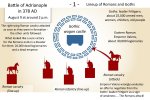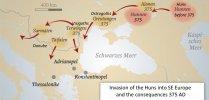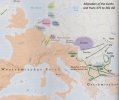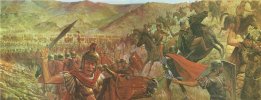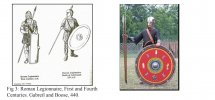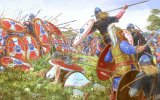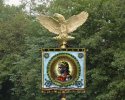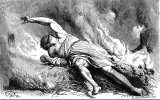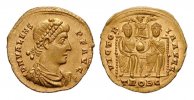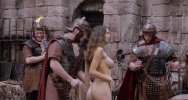Rupert_137
Governor
The Fall of the Roman Empire
We read so many stories of invincible Romans, of their arrogance, their brutal conquests and their cruel punishments, we hear about their luxurious life, supported by the enslavement of other peoples ... But no fame, no empire lasts forever. This is the story of the fall and decay of the Western Roman Empire over a period of 100 years from 375 to 476 AD, told in individual episodes (story) and supplemented with historical reviews (history).
In 375 AD, Gothic tribes crossed the Danube by mutual agreement with the Romans in order to become new settlers in the Roman Empire. In AD 476, the Gothic military leader and later King Odoacer deposed the last Western Roman emperor 'Romulus', whom they contemptuously nicknamed 'Augustulus' (little Augustus).
I invite those interested to add their own contributions to this epoch of the Romans, who are no longer used to victory ... where the Romans have to recognize that their power is not unlimited or lasts forever and that their leadership role is not determined by God.
(1) The Battle of Adrianople in 378 AD.
I begin my stories with one of the most momentous battles of late antiquity on Roman soil between the Goths under their leader Fritigern and the Romans under the Eastern Roman Emperor Valens. The Goths had come across the Danube to the Roman Empire three years earlier (375) fleeing from the Huns advancing from the east. They were accepted as new settlers, in return they were supposed to set up soldiers and secure the border to the north, and so they also kept their weapons. The Visigothic tribes were also followed – unplanned - by the equally oppressed Ostrogoths and the Alanian horsemen associations.
In the end there were around 200,000 people to be supplied, twice as many as expected. The supply did not work, the Goths were starving, corrupt provincial officials tried to enrich themselves with the already scarce aid supplies. Gothic families had to pay high prices for food, if they couldn't they had to redeem jewelry and weapons, or their daughters had to prostitute themselves for the locals, and boys should even be sold as slaves. In return, they were often only given dog food.
Riots soon broke out among the Goths. But instead of assigning them the promised settlement land and providing them with sufficient food, the provincial government resorted to a malicious trick to calm the situation in a 'Roman way'. They invited the Gothic leaders to talk over dinner. However, the Romans planned to assassinate the leaders in order to make the new settlers weak and leaderless. The project failed, Fritigern, one of the Goths leaders, escaped the attack and the anger of the Goths grew uncontrollably. For the next two years they marched raiding the Roman provinces of the Balkans in search of food and booty. This time it was the Goths who abducted local young women as living prey and who took able-bodied young men with them to reinforce their warriors.
Two attempts to stop them with the Roman forces from the region failed; Fritigern won, or the opponents parted in a draw after a bloody battle. Thereafter, the Goths had large amounts of captured Roman weapons. They moved to the gates of Constantinople, capital of the eastern part of the empire. However, they lacked the siege equipment and the necessary experience to attack this powerful city. Submissive refugees and supplicants had suddenly become dangerous invaders ... Not without the fault of the responsible Romans!
The leadership of the Roman Empire was shared by Emperor Valens for the eastern half of the empire and Emperor Gratian for the western part. But both were already involved in fighting, they had other worries. The Huns' storm had also pushed Germanic tribes to the west, where the Alemanni crossed the Rhine and invaded Roman Gaul. This tied Gratian to the Rhine border. In the far east of the empire Valerian was on a campaign against the Persians, who threatened the Roman border there. And so much time passed before the Roman rulers could intervene.
By the summer of 378 AD, Emperor Valens was able to make peace with the Persians and lead his troops back to Constantinople. Gratian advanced from the west against the Goths in the Balkans. Valens waited two weeks, but Gratian's approach was delayed. Then Emperor Valens decided to attack the Goths even without support from the West. Valens turned down offers of negotiation from her guide Fritigern. The leader of the Goths did not seek war, but rather land and peace for his people. The Eastern Roman ruler, however, wanted to discipline and punish the Goths - entirely according to Roman legal understanding - and he wanted to claim the glory for the suppression of the Goths for himself alone. He assessed the offers to negotiate as his opponent's weakness.
On August 9, 378 AD, there was a Roman attack on the Goths, who had holed up in their wagon castle. This fight would go down in history as the 'Battle of Adrianople '. Emperor Valens led around 25,000 legionnaires of his infantry into battle, reinforced on both wings by around 6,000 horsemen. Fritigern had around 20,000 men under arms to defend the Gothic wagon castle, and 4,500 riders, made up of allied Ostrogoths and Alans, hid in the woods. The Visigoth peasant tribes did not have their own cavalry.
Numerically, the Romans had a small advantage, and they also believed in their superior discipline and war experience ... but they had the disadvantage that they had to march 18 km to the slaughter site in the morning, where they arrived in the midday heat and where Fritigern awaited them well prepared. The Romans only counted on 10,000 armed defenders, they knew nothing about a Gothic cavalry and they were confident of victory ... Thirsty and tired from the march, they rushed to attack the Goths' wagon castle. A whole people had holed up behind thousands of wagons set up across and staggered and forming a large circle ... and the Goths were determined to defend their lives and their freedom against the attacking Romans.
It follows ... 'The Great Battle' a tale from the perspective of a young Gothic woman inside the wagon castle, who observed the battle but also intervened in the fight with a bow and arrows... Later, in retrospect, we learn about her humiliations and sufferings among the Romans before ... and we can also learn about her hatred...
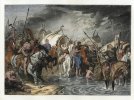
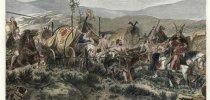

We read so many stories of invincible Romans, of their arrogance, their brutal conquests and their cruel punishments, we hear about their luxurious life, supported by the enslavement of other peoples ... But no fame, no empire lasts forever. This is the story of the fall and decay of the Western Roman Empire over a period of 100 years from 375 to 476 AD, told in individual episodes (story) and supplemented with historical reviews (history).
In 375 AD, Gothic tribes crossed the Danube by mutual agreement with the Romans in order to become new settlers in the Roman Empire. In AD 476, the Gothic military leader and later King Odoacer deposed the last Western Roman emperor 'Romulus', whom they contemptuously nicknamed 'Augustulus' (little Augustus).
I invite those interested to add their own contributions to this epoch of the Romans, who are no longer used to victory ... where the Romans have to recognize that their power is not unlimited or lasts forever and that their leadership role is not determined by God.
(1) The Battle of Adrianople in 378 AD.
I begin my stories with one of the most momentous battles of late antiquity on Roman soil between the Goths under their leader Fritigern and the Romans under the Eastern Roman Emperor Valens. The Goths had come across the Danube to the Roman Empire three years earlier (375) fleeing from the Huns advancing from the east. They were accepted as new settlers, in return they were supposed to set up soldiers and secure the border to the north, and so they also kept their weapons. The Visigothic tribes were also followed – unplanned - by the equally oppressed Ostrogoths and the Alanian horsemen associations.
In the end there were around 200,000 people to be supplied, twice as many as expected. The supply did not work, the Goths were starving, corrupt provincial officials tried to enrich themselves with the already scarce aid supplies. Gothic families had to pay high prices for food, if they couldn't they had to redeem jewelry and weapons, or their daughters had to prostitute themselves for the locals, and boys should even be sold as slaves. In return, they were often only given dog food.
Riots soon broke out among the Goths. But instead of assigning them the promised settlement land and providing them with sufficient food, the provincial government resorted to a malicious trick to calm the situation in a 'Roman way'. They invited the Gothic leaders to talk over dinner. However, the Romans planned to assassinate the leaders in order to make the new settlers weak and leaderless. The project failed, Fritigern, one of the Goths leaders, escaped the attack and the anger of the Goths grew uncontrollably. For the next two years they marched raiding the Roman provinces of the Balkans in search of food and booty. This time it was the Goths who abducted local young women as living prey and who took able-bodied young men with them to reinforce their warriors.
Two attempts to stop them with the Roman forces from the region failed; Fritigern won, or the opponents parted in a draw after a bloody battle. Thereafter, the Goths had large amounts of captured Roman weapons. They moved to the gates of Constantinople, capital of the eastern part of the empire. However, they lacked the siege equipment and the necessary experience to attack this powerful city. Submissive refugees and supplicants had suddenly become dangerous invaders ... Not without the fault of the responsible Romans!
The leadership of the Roman Empire was shared by Emperor Valens for the eastern half of the empire and Emperor Gratian for the western part. But both were already involved in fighting, they had other worries. The Huns' storm had also pushed Germanic tribes to the west, where the Alemanni crossed the Rhine and invaded Roman Gaul. This tied Gratian to the Rhine border. In the far east of the empire Valerian was on a campaign against the Persians, who threatened the Roman border there. And so much time passed before the Roman rulers could intervene.
By the summer of 378 AD, Emperor Valens was able to make peace with the Persians and lead his troops back to Constantinople. Gratian advanced from the west against the Goths in the Balkans. Valens waited two weeks, but Gratian's approach was delayed. Then Emperor Valens decided to attack the Goths even without support from the West. Valens turned down offers of negotiation from her guide Fritigern. The leader of the Goths did not seek war, but rather land and peace for his people. The Eastern Roman ruler, however, wanted to discipline and punish the Goths - entirely according to Roman legal understanding - and he wanted to claim the glory for the suppression of the Goths for himself alone. He assessed the offers to negotiate as his opponent's weakness.
On August 9, 378 AD, there was a Roman attack on the Goths, who had holed up in their wagon castle. This fight would go down in history as the 'Battle of Adrianople '. Emperor Valens led around 25,000 legionnaires of his infantry into battle, reinforced on both wings by around 6,000 horsemen. Fritigern had around 20,000 men under arms to defend the Gothic wagon castle, and 4,500 riders, made up of allied Ostrogoths and Alans, hid in the woods. The Visigoth peasant tribes did not have their own cavalry.
Numerically, the Romans had a small advantage, and they also believed in their superior discipline and war experience ... but they had the disadvantage that they had to march 18 km to the slaughter site in the morning, where they arrived in the midday heat and where Fritigern awaited them well prepared. The Romans only counted on 10,000 armed defenders, they knew nothing about a Gothic cavalry and they were confident of victory ... Thirsty and tired from the march, they rushed to attack the Goths' wagon castle. A whole people had holed up behind thousands of wagons set up across and staggered and forming a large circle ... and the Goths were determined to defend their lives and their freedom against the attacking Romans.
It follows ... 'The Great Battle' a tale from the perspective of a young Gothic woman inside the wagon castle, who observed the battle but also intervened in the fight with a bow and arrows... Later, in retrospect, we learn about her humiliations and sufferings among the Romans before ... and we can also learn about her hatred...



Last edited by a moderator:



